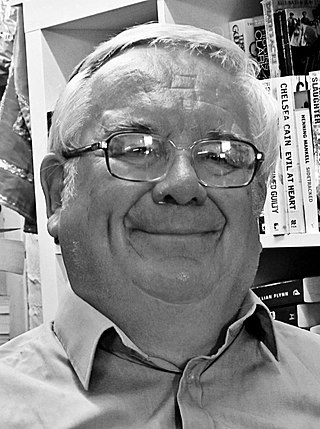The Necronomicon is a fictional grimoire from the stories of horror writer H. P. Lovecraft.
Contents
Necronomicon may also refer to:
The Necronomicon is a fictional grimoire from the stories of horror writer H. P. Lovecraft.
Necronomicon may also refer to:

The Cthulhu Mythos is a mythopoeia and a shared fictional universe, originating in the works of American horror writer H. P. Lovecraft. The term was coined by August Derleth, a contemporary correspondent and protégé of Lovecraft, to identify the settings, tropes, and lore that were employed by Lovecraft and his literary successors. The name "Cthulhu" derives from the central creature in Lovecraft's seminal short story "The Call of Cthulhu", first published in the pulp magazine Weird Tales in 1928.

Howard Phillips Lovecraft was an American writer of weird, science, fantasy, and horror fiction. He is best known for his creation of the Cthulhu Mythos.

The Necronomicon, also referred to as the Book of the Dead, or under a purported original Arabic title of Kitab al-Azif, is a fictional grimoire appearing in stories by the horror writer H. P. Lovecraft and his followers. It was first mentioned in Lovecraft's 1924 short story "The Hound", written in 1922, though its purported author, the "Mad Arab" Abdul Alhazred, had been quoted a year earlier in Lovecraft's "The Nameless City". Among other things, the work contains an account of the Old Ones, their history, and the means for summoning them.

Robert Albert Bloch was an American fiction writer, primarily of crime, psychological horror and fantasy, much of which has been dramatized for radio, cinema and television. He also wrote a relatively small amount of science fiction. His writing career lasted 60 years, including more than 30 years in television and film. He began his professional writing career immediately after graduation, aged 17. Best known as the writer of Psycho (1959), the basis for the film of the same name by Alfred Hitchcock, Bloch wrote hundreds of short stories and over 30 novels. He was a protégé of H. P. Lovecraft, who was the first to seriously encourage his talent. However, while he started emulating Lovecraft and his brand of cosmic horror, he later specialized in crime and horror stories working with a more psychological approach.
Miskatonic University is a fictional university located in Arkham, a fictional town in Essex County, Massachusetts. It is named after the Miskatonic River. After first appearing in H. P. Lovecraft's 1922 story "Herbert West–Reanimator", the school appeared in numerous Cthulhu Mythos stories by Lovecraft and other writers. The story "The Dunwich Horror" implies that Miskatonic University is a highly prestigious university, on par with Harvard University, and that Harvard and Miskatonic are the two most popular schools for the children of the Massachusetts "Old Gentry". The university also appears in role-playing games and board games based on the mythos.

Ramsey Campbell is an English horror fiction writer, editor and critic who has been writing for well over fifty years. He is the author of over 30 novels and hundreds of short stories, many of them winners of literary awards. Three of his novels have been adapted into films.

Frank Belknap Long was an American writer of horror fiction, fantasy, science fiction, poetry, gothic romance, comic books, and non-fiction. Though his writing career spanned seven decades, he is best known for his horror and science fiction short stories, including early contributions to the Cthulhu Mythos. During his life, Long received the World Fantasy Award for Life Achievement, the Bram Stoker Award for Lifetime Achievement, and the First Fandom Hall of Fame Award (1977).
Theodore "Eibon" Donald Klein is an American horror writer and editor.

"The Haunter of the Dark" is a horror short story by American author H. P. Lovecraft, written between 5–9 November 1935 and published in the December 1936 edition of Weird Tales. It was the last written of the author's known works, and is part of the Cthulhu Mythos. The epigraph to the story is the second stanza of Lovecraft's 1917 poem "Nemesis".
Unaussprechlichen Kulten is a fictional book of arcane literature in the Cthulhu Mythos. The book first appeared in Robert E. Howard's 1931 short stories "The Children of the Night" and "The Black Stone" as Nameless Cults. Like the Necronomicon, it was later mentioned in several stories by H. P. Lovecraft.

Lovecraftian horror, sometimes used interchangeably with "cosmic horror", is a subgenre of horror fiction and weird fiction that emphasizes the horror of the unknowable and incomprehensible more than gore or other elements of shock. It is named after American author H. P. Lovecraft (1890–1937). His work emphasizes themes of cosmic dread, forbidden and dangerous knowledge, madness, non-human influences on humanity, religion and superstition, fate and inevitability, and the risks associated with scientific discoveries, which are now associated with Lovecraftian horror as a subgenre. The cosmic themes of Lovecraftian horror can also be found in other media, notably horror films, horror games, and comics.
Necronomicon Press is an American small press publishing house specializing in fiction, poetry and literary criticism relating to the horror and fantasy genres. It is run by Marc A. Michaud.
Peter Levenda is an American author who focuses primarily on occult history. He is best known for his book Unholy Alliance, which is about Esoteric Hitlerism and Nazi occultism.
Necronomicon was the first major published compendium of images by Swiss artist H. R. Giger. Originally published in 1977, the book was given to director Ridley Scott during the pre-production of the film Alien, who then hired Giger to produce artwork and conceptual designs for the film.
The Book of the Dead is an ancient Egyptian funerary text.

Leigh (David) Blackmore is an Australian horror writer, critic, editor, occultist, musician and proponent of post-left anarchy. He was the Australian representative for the Horror Writers of America (1994–95) and served as the second President of the Australian Horror Writers Association (2010–2011). His work has been nominated four times for the Ditmar Award, once for fiction and three times for the William Atheling Jr. Award for criticism. He has been a Finalist in both the Poetry and Criticism categories of the Australian Shadows Awards. He has contributed entries to such encyclopedias as S.T. Joshi and Stefan J. Dziemianowicz (eds) Supernatural Literature of the World and June Pulliam and Tony Fonseca (eds), Ghosts in Popular Culture and Legend.
"History of the Necronomicon" is a short text written by H. P. Lovecraft in 1927, and published in 1938. It describes the origins of the fictional book of the same name: the occult grimoire Necronomicon, a now-famous element of some of his stories. The short text purports to be non-fiction, adding to the appearance of "pseudo-authenticity" which Lovecraft valued in building his Cthulhu Mythos oeuvre. Accordingly, it supposes the history of the Necronomicon as the inspiration for Robert W. Chambers' The King in Yellow, which concerns a book that overthrows the minds of those who read it.
"The Return of the Sorcerer" is a horror short story by American writer Clark Ashton Smith, first published in Strange Tales of Mystery and Terror in September 1931. The story ties into H. P. Lovecraft's Cthulhu Mythos due to its references to Lovecraft's invented book of occult lore the Necronomicon. It tells of one Mr. Ogden being hired by scholarly recluse John Carnby to translate passages from the Necronomicon.
The NecronomiCon Providence, also known as the NecronomiCon Providence: The International Conference and Festival of Weird Fiction, Art, and Academia, is a biennial convention and academic conference held in Providence, Rhode Island. It explores the life and works of creators of weird fiction, film, and art of the past and the present. Originally billed as "the largest celebration ever of [Lovecraft's] work and influence", it has broadened its scope to examining and celebrating weird creative efforts internationally. The event is typically held on the weekend closest to Lovecraft's birthday of August 20th.